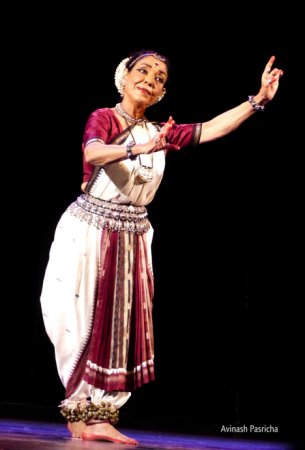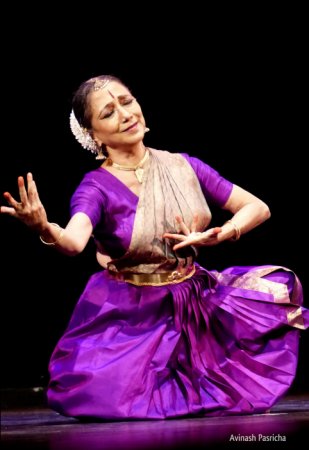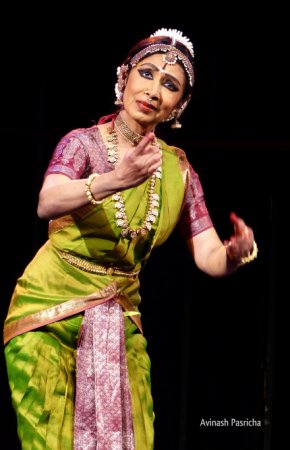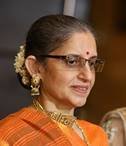
|   |

|   |
Day 2 of Saroja Mohanam - Shveta Arora e-mail: arorashveta1806@gmail.com Photos: Avinash Pasricha December 10, 2022 Ashish Mohan Khokar's Saroja Mohanam was an event that paid tribute to his parents, Mohan Khokar and M.K. Saroja, pioneers in the field of classical dance and dance scholarship. Day 1 of the event featured Kavita Dwibedi, Navtej Johar and Aditi Mangaldas. The second day was equally star-studded, featuring Madhavi Mudgal, Leela Samson and Alarmel Valli.  Madhavi Mudgal On the second evening, the program started with a flute recital, a kriti, by G. Raghuraman, and a prarthana recited by S. Vasudevan. The first dancer-guru to take the stage was Madhavi Mudgal. As soon as she began her performance, there was a glitch in the audio system, but despite that she began with the confidence of a seasoned performer. The poetry was written by Dr. Mayadhar Mansingh and choreographed by Madhavi Mudgal. The poetry was an ode to Lord Nataraja and an invocation of the dancing Shiva. The peacock looks at the sky when it is overcast with clouds and spreads its feathers and dances. O Nataraja,' the dancer prays, please grant me that grace so that I can look at you and dance like a peacock. The lotus blooms and bends towards the sun's rays as they fall on it. The bhakta desires the same as he sees the sun of his god's face. The waves dance when they see the full moon. Please grant me the same grace with which you dance the ananda tandava, playing the damaru in your hand, says the bhakta. The ornaments on your wrist make the music, so please grant me that grace so that I too can make music out of my ghungroos. Madhavi Mudgal's peacock moves were very graceful. She depicted the lotus blooming in the presence of the sun's rays. The waves of her hands showed the moving in circles of the waves of the ocean. Further, she depicted the music made by Shiva's ornaments and instruments like the damaru, khol and mridangam. She ended the piece gracefully with the peacock moves, showing the bhakta dancing in ecstasy. It was an awesome performance. The next piece was a Jayadeva ashtapadi. Here, Krishna is pining for Radha and he sends the sakhi to get her. The sakhi urges Radha to go to him immediately and meet Krishna because this is her moment to unite with him. The music was by Madhup Mudgal and the choreography was her own. The poetry says "Radhike kshanamadhuna Narayanam anugata manusara" - that this is the right moment for her to go to him. He has made a bed of tender leaves and petals or kisalaya shayana for her and this is the time that she should step on them and trample them. As Radha moves into the cove on the bed of soft leaves, holding her ghunghat, Krishna presses her feet, since she has travelled afar and is tired. He pleads with her to bestow on him the nectar of her lips - 'Adhar sudha ras' - and gently, he turns Radha's face towards him and lifts her face up to plant a gentle kiss. Madhavi's nimble footwork, subtle hastas, delicate movements and apt abhinaya suited the composition.  Leela Samson The second dancer/guru for the evening was Leela Samson in Bharatanatyam. She was dressed in a magenta sari. The first piece was "Amba Neelambari" where the bhakta pleads, 'O mother, protector, come to me.' It was sung by Vignesh Ishwar in ragam Neelambari, adi tala, composed by Ponnaiah Pillai. She has eyes like a lotus, her hands are like lotuses, her arms like the lotus stems, feet like the lotus and lips like lotus petals, which the bumblebee mistakes for flowers. A parrot rests on her shoulder. She is the one who bestows her bhaktas with protection from evil. She is the one who is Lord Krishna's younger sister. The evocative lyrics were sung in a lyrical manner by Vignesh. The abhinaya and gestures were presented in a gentle, graceful manner, referring to Amba's attributes. Her nritta was graceful and lithe, moving gently across the stage. Finally, she ended the piece with the bhakta looking for her Amma's darshan and on seeing a glimpse of her, she kneels. The final posture, with one leg resting on the other and the light falling from behind her, was ethereal. The spotlight was on her while the other area was dark, giving the light a halo-like look. It was a sublime experience for all. The second piece she performed was in raga Khamas, a javali. Here, the nayika pleads with her friend to go and get her Lord Srinivasa to her, since Kamadeva is fully armed to attack her. Leela Samson started with the nayika looking around for him, and then she reminisces that he would come from behind her and hold her and she would look around at his face. When she realizes that this is just her imagination, she is in total despair as Kamadeva's arrows strike her. She looks for her sakhi and tells her to go and get Lord Srinivasa immediately. While she is bearing this agony, he is enjoying having a dalliance with another woman. The dancer's eyes were wet with emotion. The nayika praises the sakhi and asks her to go immediately to get the lord back. The abhinaya for the piece was graceful and evocative.  Alarmel Valli The last guru on stage for the evening was Alarmel Valli. Valli was dressed in a green and magenta costume and looked petite, with all the finery of Bharatanatyam aharyam and jewellery. The first piece was about a philandering lover and in a sarcastic manner, Valli depicted, 'Do not touch me, the great handsome hero that you are.' The young wrathful nayika is beyond reconciliation. 'You are a hypocrite and lied to me about your undying love in your letters. You are tied to the pallu of your seductress. Don't dare touch me with the hands and arms that have embraced her,' she depicted in her flawless abhinaya. Valli began seated, waiting for her lover. As she sees him coming late, she realizes that he is coming back after a dalliance with another woman. She mocks him and keeps pushing his hands away when he tries to reconcile with her. She even pulls the pallu of her sari away from him. Furious, she keeps telling him that all his promises of an undying love were a lie. She tears up all his letters, crumples them and throws them away. Further, venting at him, she tells him that when he dressed up in front of the mirror and put the scents of ittra on himself and walked out of his house, he probably forgot the way back and mistook another woman's house for his own. And that the coy maiden in her veil or ghunghat was in fact a seductress. Finally, she tells him that she has washed her hands off him. It was an abhinaya piece and Valli's mukhabhinaya and enactment was expressive of anger and disgust. The emotions were brought out naturally, making the piece sarcastic and humorous. The concluding piece was my favourite for the evening. This was a rare bhakti composition by Annamacharya. Here, the bhakta's voice is wrapped in confusion. He is baffled and tearful and longing for the divine. The seeker longs to experience the lord as the sarvavyapak (all-pervasive) Brahma. He says, you are the cosmic all-pervading lord, so give me the darshan or the epiphany of that intangible form. You are visible to me and yet hidden. The music was composed by Prema Ramamurthy in ragam Charukesi. The composition shows that while worshipping the saakar (with form) form of Ishwar or the super-soul, the bhakta pines for the niraakar or the formless Ishwar. He does not desire materialistic goods but wishes to see the all-pervading lord and finally surrender to him. Valli began seated again, as the bhakta who calls for the lord with his hands raised. As he sees the four-armed form of Lord Vishnu, he embraces his feet. The bhakta performs seva puja for his Gopal. He bathes the idol of the lord, applies chandan, collects flowers and strings them into a garland to offer to his Gopal. He, with all his veneration, performs the aarti and then chooses the fruits to offer. As he plays on the veena, he sings the kirtan and offers it to his Gopal. And yet, he longs for the darshan of Lord Venkatesh. He calls upon his lord to shower him with his mercy, since he is all-pervading. Why should he be drowning in the ocean of grief and separation for a glimpse of him? He says that the lord is not fathomable through the buddhi or mind of a mortal like him. Finally, he surrenders all at the feet of the unfathomable and all-pervading super soul. The music was very soulful and every emotion that the bhakta feels, Valli was one with it. As she venerated Lord Venkatesh, and drowned in the viraha sagar in surrender, everybody in the audience was moved.  Shveta Arora is a dance-mad writer who chronicles classical dance events in Delhi. Ten years ago, she started the blog Kala Upasana at delhiculturecomment.blogspot.com, where she began posting her own writing along with photographs clicked by Anoop Arora, her husband. She's been dancing all her life as a devotee, but resumed her formal training in Kathak in her 50s and has passed her fourth year Kathak exams. |